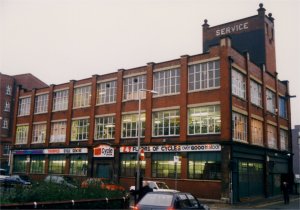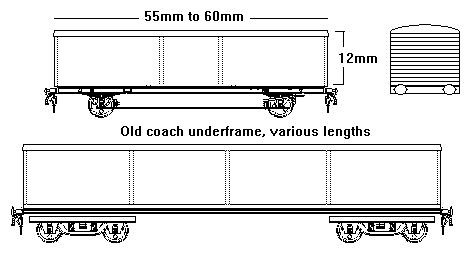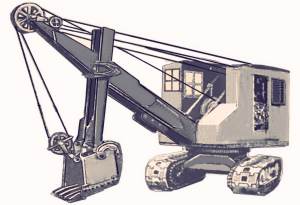Motor Cars, Commercial Vehicles, Construction and Farm Machinery
Smaller motor car factories tended to buy-in most of the components and functioned as design and assembly plants. Motor car and other forms of road and farm vehicle manufacture are all candidates for the back-scene, the premises tended to be extensive and with little penetration by railway lines. All that is required is a couple of long sidings, for those where the vehicles are driven on a ramp or end-loading platform is required at the end.
The location of motor car factories was determined by many factors, Ford's first factory in Manchester was close by the docks to allow the import of parts and in 1906 Rolls Royce considered building their new factory in Leicester but the electricity in Derby was cheaper. Broadly speaking motor car production in Britain has been based in Coventry, Birmingham, Manchester and Liverpool, the massive Leyland works had so much internal railway they needed two full size signal boxes to control all the available sidings. Commercial vehicles however were more widely dispersed, these are discussed after the motor car trade below.
British motor car factories have no characteristic distinguising features, other then the large number of cars in evidence. In America where mass production of motor cars was born a lot of the factories were established inside already built-up areas and purpose built multi-story buildings allowed production to spiral down through the works. The Italians followed the American model, the Fiat factory even has the test track laid out around the roof. In Germany motor car production featured numbers of multi-story engineering workshops.
British motor car factories tended to be organic arrangements of single story buildings which built up over time. Only after the second world war did the characteristic large purpose built single storey buildings appear. There were a few atypical factories, Fords first factory in Manchester was still a multi-story building. This was really just an assembly plant however, the parts were delivered (by road from the neaby docks) and hoisted to the top floor using a large internal lift. The car was assembled and fitted out on the upper two floors and lowered complete to the ground floor show room.
Fig ___ Early Ford factory

Unlike their American and larger Continental rivals the British car makers did not make their own steel or their own glass. Most British motor car firms relied on third party suppliers for many of their components, up to and including engines, gear boxes, brake systems and bodywork. Almost all the electrical parts, coils, lamps etc, used in British cars were made by one firm (Lucas). The British motor industry grew up as a patchwork of small firms, the interrelationships were complex and firms often made parts for each other.
The body panels were designed by the car manufacturer but up to the 1920's they were usually produced by a small number of specialist firms. The two largest were Pressed Steel Ltd of Oxford (close by the Morris factory at Cowley) and Fisher & Ludlow of Birmingham and Tile Hill (close by the Standard Motor Co works at Canley) but other, smaller, firms existed, notably Mullins of Birmingham (absorbed by Standard Motor Co in the 1950's) and Briggs Motor Bodies. By the later 1920's the body makers had mostly been bought by the motor car firms but they retained their original factories, necessitating the transport of bodies to the car factories.
Even fitting out the interiors was often contracted out for more up-market motor cars, Hillman, Humber and other members of the Rootes group often used Thrupp & Maberley, the oldest firm in the Rootes Empire, established as carriage builders in the 1780's.
With all these different firms involved in car production there was a healthy trade for the railways on moving the parts and partly assembled vehicles from plant to plant and for carrying the finished cars, vans and lorries to the distributors. By the 1930s the railways were offering long flat wagons based on old coach under-frames for car traffic, these would normally be loaded via an end-loading dock at the factory and the receiving end, if traffic was not regular however simple metal trays could be laid up against the end of the wagon from the ground and the car driven on or off on these.
There is a photo of a Rolls Royce chassis being loaded onto a flat wagon by crane in Bob Esseries book on MR wagons (Vol 1) but generally speaking the bodies or body parts were delivered to the chassis makers rather than the other way round. The railways provided a range of vans for this kind of traffic, the Great Western Railway built a small fleet of BOCAR vehicles, based on converted four wheeled and bogie passenger coaches for traffic from Pressed Steel to the Morris works at Cowley. These vehicles had plain ends, a low almost flat roof and canvass 'curtain' sides. British Railways were still converting 57' redundant passenger coaches for this traffic into the 1960s.
Fig ___ Bocar motor body vans

By the 1960s complete car bodies were being shipped with a base coat of red-brown primer, stacked two high in simple metal frames that were lifted by fork lift onto open bogie flat wagons. Pressed Steel was still using railway company vans to ship motor car body parts for British Leyland in the 1980's.
Chassis and part completed commercial vehicles were also routinely shipped by rail. Commercial vehicles were never built in anything like the same numbers as cars and particularly with lorries and trucks the old practice of one firm building the chassis and sending this to another factory to have the bodywork added continued into the 1960's.
In the 1950's BMC partners Morris and Austin routinely shipped the chassis with a basic cab of their light vans to a third plant for the rear bodywork to be added.
Since the later 1950's there has been a shift to using multi-decked car transporters for rail movement of cars (the N Gauge Society offer their members a kit of the Cartic Four unit), commercial vehicles tend to be larger and these are usually shipped on single decked vehicles.
The early double-decked motor car carriers used a lifting central section to allow all cars to be loaded at a single level but this proved a time consuming exercise. Modern double-decked rail vehicles are loaded either from a fixed double ramp at the end of the sidings offering access to both levels or via a railway bogie flat wagon mounted ramp which can be adjusted to feed the upper or lower decks of the transporters.
A series of lengthy sidings will be required to portray a modern depot, but the 'works' itself can be painted on the back-scene.
Commercial Vehicles
Production of commercial vehicles was overshadowed by the tremendous growth in motor car manufacturing industry from the late 1930's. There were however many firms producing commercial vehicles, buses and farm tractors. For anyone interested in British commercial vehicles there is a rather good truck museum at Leyland (see also Appendix One - Steam and Motor Commercial Vehicles).
Most lorry builders provided only the chassis and cab, the rear body was then added by firms specialising in this work. The chassis, often without even a cab, was usually delivered to the coach builders by road (running on trade plates). There was a limited traffic for the railways in road vehicles of this type but lorries are not built in the same numbers as cars so rail shipments would be infrequent. As an example Foden, one of the larger lorry builders, was producing only sixty chassis a week when it was at full capacity in the 1970's.
Having said which a lot of lorry builders started out as iron works and the like and many establishments had a siding or two laid into their premises. These sidings could be used for the supply of parts and raw materials to the factory. Foden's started as an iron works and had a single siding capable of holding fourteen wagons of nine foot wheelbase. The North Staffordshire Railway paid for the siding and required a 'public' loading wharf on the opposite side from the factory to pick up local agricultural and other traffic.
In the 1980's Leyland (and later Leyland Daf) shipped chassis with cabs for export via ports on the North East Coast. These shipments were accomplished using a range of vehicles including modified Freightliner flats and the purpose built Comtic articulated transporter. The latter can be produced from a Lima articulated car transporter by removing the upper deck and its supporting struts. A single Comtic would carry three lorries with one bridging the join in the middle.
Construction Equipment
Lincolnshire is well known for its road rollers.
Fig___ Typical 1930s diesel excavator

Larger caterpillar tracked cranes were often built to take a range of jib types. A good example is the Thomas Smith & Sons (Rodley) Ltd 'Three Twelve' convertible excavator. This Leeds firm offered the same basic diesel powered crane with a long lattice jib to carry a drag-line in a sand quarry, a conventional excavator, a short heavy jib with a simple scoop excavator and a pile-driver.
The sketches below show the three earth moving types, the drawings are loosely based on several prototypes and are intended to make construction as easy as possible. The cab shown is simply a cut-down Peco refrigerator van body with some windows added. The digger had the side door open, this is easy to represent; cut away the inner door from the van side and add a rectangle of 1mm scribed card over the remaining door with strapping detail from strips of sticky tape to represent the open door. The inside of the door would be unpainted, I would suggest a mix of 'dark earth' with a little black added. The scraper and drag cranes are shown with the door closed, which it would be if the vehicle were being transported by rail.
The chassis is made up of several layers of 30 thou card with tracks added as described earlier (see Fig ___).
The jib on the digger is made from two lengths of Plastruct H section, the length attached to the bucket being small enough to pass through a hole in the web of the main jib (Plastruct references xxx). The bucket is a 12mm length of Plastruct square section tube reference STFS-12 which is 9.5mm square. Cut one end to the profile shown and notch the lower edge to accept short lengths of 10x20 thou strip which represent the 'teeth'. Cut a square of 30 thou card for the rear of the bucket and use lengths cut from small bolts to represent the pulley wheels.
The jib on the scraper is simply a Plastruct I section with the bucket made from Plastruct rectangular section tubing (XXX), the 'teeth' and rear door are added as above.
The suggested jib for the drag crane is two OO scale lattice signal masts (such as those from the Ratio LNER signals kit) with their bases glued together to form a single long jib. This is not as illustrated and it would be rather longer than the example shown. The bucket is made as for the scraper but the rear panel is not a door so fill the end with Milliput and sand to shape.
Farm equipment
Lincoln is famous for agricultural machinery and Gainsborough and Grantham are also centres.
The first petrol powered farm tractor was built in America in 1892, the first British farm tractor was the three-wheeler Ivel of 1903 (developed by a bicycle maker in Birmingham). By the time of the First World War there were quite a few tractors on the market but farmers being a conservative bunch there were few at work in the fields. Horses and oxen were still in widespread use but the demands of war left the farms short of both labourers and horses and the Government asked the Americans for assistance. The tractors which arrived from America were mainly built by International Tractor. These machines would look familiar today, they have the standard arrangement of two larger wheels at the rear with two smaller wheels in line with these at the front, but the 'tyres'on the rear wheels were plain metal with diagonal metal ribs across them.
At the time a lot of farm equipment such as threshing machines and the like was driven by belts, usually from a steam traction engine or portable (tow-able) steam engine. The petrol tractors had flywheel like arrangements to either side of the bonnet to drive the belts on this kind of equipment.
The 'caterpillar' tractor appeared in 1931 but they were little used in Britain. One example is shown in the sketch below, a machine intended for tilling the ground at sugar plantations in tropical countries it was first built in 1935. Small numbers of these machines would have been shipped to the docks by rail, probably in one's two's or three's.
The hard times of the 1930's left many farms bankrupt and delayed investment in tractors. By the time of the Second World War much farmland was idle but the farmers lacked the men and resources to plough it under for crops. Again the Americans helped by sending tractors, the most common type this time as built by Fords, who's commercial vehicles were called Fordsons.
At the time there were a lot of three wheeled tractors in use and some of the American machines had the two front wheels mounted close together, giving effectively a three wheeler arrangement.
Throughout the war horses and oxen remained in common use on the land and equipment such as ploughs which had been designed for horse haulage or steam engine towing remained in use.
A good example is the Balance Plough, used with pairs of steam ploughing engines. This had two sets of blades arranged on frames which were mounted in a shallow V with a large pair of wheels at the apex. The engines would drive to either side of the field and a continuous rope would be laid across the field and round the hoisting drums mounted under the tractors. The rope was attached to the plough, the trailing set of blades were set into the ground and the engine on the far side pulled the plough across the field. Once it reached the engine the plough was tipped so the second set of blades dug into the ground and the engine on the far side would pull it back whilst the first engine moved to position itself for the next run. These ploughs continued in regular use, although hauled by tractors rather than steam ploughing engines, into the 1960's.
The most common colour for tractors in the pre-war era was (I believe) red. Massey-Harris or the later Massey-Ferguson tractors are definately red, Fordson (the commercial wing of Ford) tractors were grey until 1932 when production moved from Cork in Southern Ireland to Dagenham and they changed to a dark blue (similar in shade to the Graham Farish LNER sand wagon) with light grey exhausts. By the later 1930's early forms of hydraulic rams were available, although they were little used in practice, but shortly after the war Ferguson's of Coventry introduced their revolutionary T series tractors which were painted grey.
The little Ferguson had a hydraulically powered frame at the rear, called a three point linkage, and a rotating power take off point mounted under that. It was designed to use specially built equipment fitted up to use the linkage and power coupling on the tractor. Fergusen provided a big range of equipment including ploughs, grass cutting shears, and powered muck spreaders. The Fergusen system meant that one man could both drive the tractor and operate the equipment and it revolutionised farming practice.
By the 1970's Britain had the highest density of tractors and the highest number of tractors per head of population in the world. Oddly enough in France, an unquestionably industrialised country, has the lowest proportion of tractors, but it does have the largest number of cows per head of population.
Tractors would have been shipped as one-offs, probably on a simple one plank wagon, although in the post war era a rake of perhaps four or five wagons might be seen heading for the docks loaded with tractors for export. For examples of tractors as wagon loads see also Wagon Loads and Materials Handling - Road Vehicles, Industrial and Farm Machinery.
Tractors (and other farm equipment) were produced in small numbers in (comparatively) small factories, these can be represented with a long low building on the backscene with a siding or two in front. At the docks and railway goods yards tractors were commonly lifted on and off wagons using a crane and a simple hand operated 'yard crane' probably did the same job at most tractor factories. A threshing machine would require an end loading dock and a drop centre wagon to carry it, ploughs were generally quite small other than the steam ploughing kit and would probably have been shipped in an open wagon. Items such as hay-turning equipment or the more modern gear such as the 'forage havester' (a tall rectangular box with a 'lawn mower' at the base, used to cut grass and blow it into a trailer) could be carried on one plank wagons or plate wagons, loaded from the side using a loading bank or platform.
^
Go to top of page


